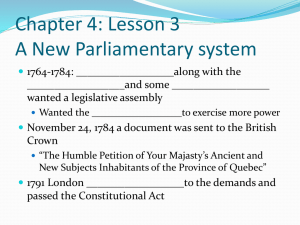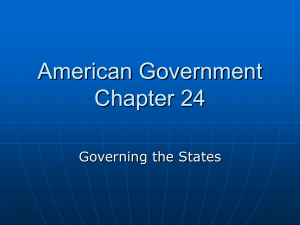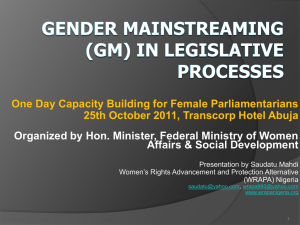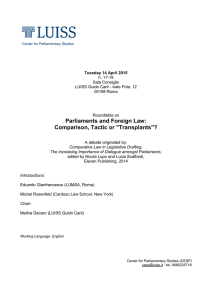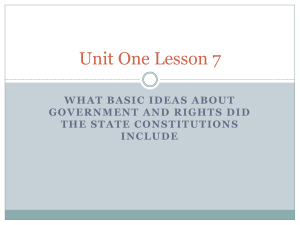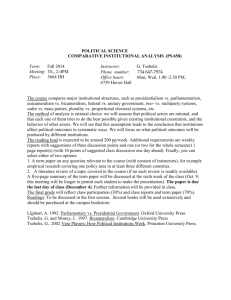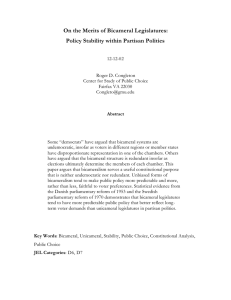File - Luca Verzichelli
advertisement
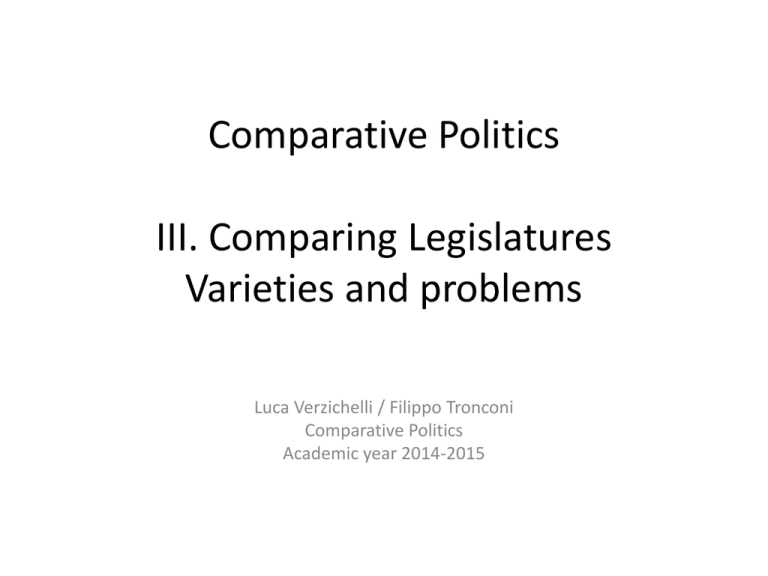
Comparative Politics III. Comparing Legislatures Varieties and problems Luca Verzichelli / Filippo Tronconi Comparative Politics Academic year 2014-2015 How to compare among parliaments? Examples from old pieces of research • • • Shaw & Lees (eds.), Committees in Legislatures, 1979. Truly comparative (n 8). Party and institutional factors under review. Strong committees in both the systems Kornberg & Musolf (eds.), Legislatures in developmental perspective, Durham, Duke University Press, 1970. See the chapter of Packeman on Brazilian congress Mezey, Comparative legislatures (1979). 5 cases (Us, Uk, Pak, Phi, URSS) and a broader comparison: Policy making power and organisational matters: Vulnerable vs. active legislatures Recent approaches to the variability of parliamentary functioning • Practices of parliamentary rule. Empirical extensive study of parliamentary devices: Doering 1995, Parliaments and Majority Rule in Western Europe (download: http://www.unipotsdam.de/db/vergleich/Publikationen/Parliaments/PMR-W-Europe.pdf ) • The central link in the delegation chain: studies of rational micro-institutional behaviours (Bergmann, Mueller & Strom, Delegation and Accountability in Parliamentary Democracies, 2003) • Intensive studies of legislative impact and “delegation” to government (Shugart & Carey: Presidents and Assemblies, 1992; Rasch, & Tsebelis, The Role of Governments in Legislative Agenda-setting, 2011 What do parliaments make? Traditional and recent concerns • The traditional classification (parliamentary) assemblies vs. (presidential) congresses.... • ... but a broad variability in both the classes is evident since the beginning of the process of democratization. • Differences emerged more clearly with the development of several European systems. • Many schemes recently produced in order to classify legislatures 1) according to their level of viscosity (Blondel et al., Legislative Behaviour: Some Steps toward a Cross-national measurement, Government and Opposition, 1, 1970, pp. 67-85) 2) to their legislative strength in relation to the executive (Mezey, 1979. Comparative Legislatures; Norton, 1993. Does Parliament Matter?) 3) the evolution of their primary function (Debating vs. Policy making, questioning etc.), (Olson, 1980,. The Legislative Process: A Comparative Approach) Legislatures: traditional and modern functions Bagehot (1867) The English Constitutions • • • • • Elective Expressive Teaching Informing Legislative Towards a new classification of parliamentary functions • Making and breaking government • Executive control - Budget - Oversight • Policy making - Residual legislative capabilities - Delegation to government - Cooperation with other institutions • Formation of political agendas Recent relevant contributions to the comparative study of cameral structure • Parliamentary articulation as dimension of a given democratic pattern (see Lijphart 1999) • Parliamentary articulation as an expression of a general institutional design (see for instance Patterson and Mughan 2001) • Parliamentary articulation as a set of institutional and partisan veto points (Tsebelis 2002). Bicameralism as veto power (Heller 1997) • Hypothesis: the more numerous the actors who can kill legislation or influence its content, the more deals must be cut to pass a budget. → Bicameralism sets up a bilateral veto game between legislative chambers, which leads to higher government budget deficits, all else constant. Study on 17 democracies (some bicameralism with different powers and organization) Dependent variable: Long term (1965-1990) rates of budget deficit A bilateral veto game between two chambers Chambers want to spend money in different ways. Point z* is the ideal point on the contract curve between the ideal points of the 2 chambers. However, with no hard budget constraints imposed by the government, it is likely that the overall spending will be higher given the expectations from both the chambers Z1 is the point where both the chamber will be able to maximise their interest Evidences from Haller (1997) Government budget deficits are higher when policy conflicts are built into the budget process in form of a bilateral game between legislative chambers Bicameralism matters. But this has not to do (only) with political composition and legislative functions. Agenda powers, Voting procedures and committee systems are also relevant The theory of institutional veto points will be refined by Tsebelis and Money (Bicameralism, 1997) Lijphart (1999, chapter 11) Bicameralism as indicator of “consensus pattern” • Variety of bicameralism summarised in terms of strong and weak bicameralism • Measurement based on legislative functions and political composition (not dissimilar from Norton and other comparative studies) • Strength of the internal parliamentary articulation as a dimension of the “federalunitary dimension” of a democracy • Strong bicameralism: symmetrical and incongruent chambers [4] Australia, Switzerland, Germany, US • Medium strength bicameralism : symmetrical and congruent [3] Belgium, Japan, Italy, Netherland • Medium strength bicameralism: asymmetrical and incongruent [3] Canada, France, India, Spain, Venezuela • Between Medium and weak bicameralism [2,5] Botswana, Uk • Weak bicameralism [2] Austria, Ireland, Sweden, • One-and-a-half-chambers [1,5] Norway, Iceland • Unicameralism [1] Finland, Greece, Israel The relationship between decentralization and cameral structure in 36 democracies (1945-1996) • Strong relation: • Bicameralism strong in federal or highly decentralised democracies • Non surprising deviant cases: decentralised small countries or unitary state with “consensus spirit”
